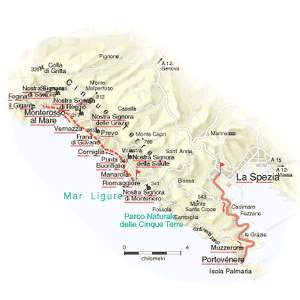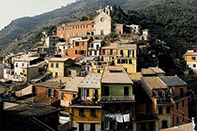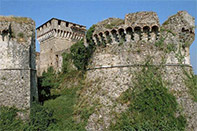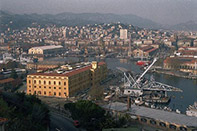Eastern Liguria and The Cinque Terre
 The itinerary leaves from Castelnuovo Magra in the eastern part of Liguria and goes towards the Luni area (the “Lunigiana”) where it turns back on itself and goes west to the Cinque Terre. The vineyards of the Cinque Terre extend over about 400 hectares of sheer-drop terraces facing the sea and have been carved out of the rock on pebbly slopes by hard manual work in the effort to plant vines and olive trees. Winemaking traditions have made this coastal area one of the most interesting and fascinating sights of the region.
The itinerary leaves from Castelnuovo Magra in the eastern part of Liguria and goes towards the Luni area (the “Lunigiana”) where it turns back on itself and goes west to the Cinque Terre. The vineyards of the Cinque Terre extend over about 400 hectares of sheer-drop terraces facing the sea and have been carved out of the rock on pebbly slopes by hard manual work in the effort to plant vines and olive trees. Winemaking traditions have made this coastal area one of the most interesting and fascinating sights of the region.

Riomaggiore
The village, at the eastern end of Cinque Terre, was originally surrounded by walls. The present village is supposed to have been founded in the 8th c. bc by a colony of Greek fugitives but what is certain is that it became part of the Genoese territories in the late Middle Ages. It is laid out in two groups of tall, narrow houses with various access levels. Above the village are the ruins of a castle. The central church of San Giovanni Battista displays a splendid 14th-c. rose window in its facade, which was restored during the last century. Nearby is the house in which the painter Telemaco Signorini lived.
Monterosso al Mare
The most westerly of the Cinque Terre, it is also the only one to have a real beach. The village dates back to the 11th c. and is divided into the two settlements of Fegina and Monterosso, running along a perpendicular axis to the sea. There are still some ancient buildings, among which are the ruins of the Genoese fortifications. In the church of San Francesco, which rises on the hill of San Cristoforo inside the convent of the Capuchins, there are some valuable paintings, such as a Crucifixion generally attributed to van Dyck. Although its urban expansion due to tourism has not always been well thought out, especially in the hilltop part, Monterosso has remained famous for producing an excellent white wine.
Manarola
Part of Riomaggiore, to which it is linked by the famous ‘Via dell’amore’, a scenic promenade carved out of the rock. The name probably derives from the Latin Manium arula, small altar of the Mani, and is a testimony to the Roman inhabitation of the area. The houses are partly built on a cliff with a sheer drop to the sea, descending towards a tiny harbour.
Corniglia
Situated on the edge of a cliff above the sea, it is administratively a part of Vernazza, with a long stairway linking it to the latter’s railway station. It lies on the edge of a wide South-facing basin, where vines and olives have been cultivated since immemorial time. The village, and its style of construction, looks more like those inland than the neighbouring coastal ones. The church of San Pietro, originally of Ligurian Gothic Style, dates back to the 14th c
Sarzana
 This important communications hub between the Cisa pass and the coast is situated near La Spezia, on the Magra plain. Of medieval origin, it was long disputed by the powerful cities of Genoa, Pisa, Lucca, Milan and Florence. That did not prevent its flourishing urban development in Renaissance times, as are witness the Medici fortress, a stronghold built by Lorenzo the Magnificent, and, more especially, the numerous grand 17th- and 18th-c. buildings. In its cathedral of Santa Maria Assunta, finished in 1474, the Altarpiece of the Purification, by Leonardo Riccomanni of Pietresanta, a splendidly articulate Renaissance work, the Coronation, a marble polyptych by the same author and the Cross of Master Guglielmo, a precious canvas by an anonymous artist dated to 1138, have been preserved.
This important communications hub between the Cisa pass and the coast is situated near La Spezia, on the Magra plain. Of medieval origin, it was long disputed by the powerful cities of Genoa, Pisa, Lucca, Milan and Florence. That did not prevent its flourishing urban development in Renaissance times, as are witness the Medici fortress, a stronghold built by Lorenzo the Magnificent, and, more especially, the numerous grand 17th- and 18th-c. buildings. In its cathedral of Santa Maria Assunta, finished in 1474, the Altarpiece of the Purification, by Leonardo Riccomanni of Pietresanta, a splendidly articulate Renaissance work, the Coronation, a marble polyptych by the same author and the Cross of Master Guglielmo, a precious canvas by an anonymous artist dated to 1138, have been preserved.
Vernazza
 Laid out in a semicircle around the small port and protected by a high cliff, it is perhaps the most picturesque village of the Cinque Terre. Looking out onto the square is the small church of Santa Maria di Antiochia, with its two storeys and curious Gothic forms, which complement the loggias and carved doorways of the surrounding old buildings so well. In the upper part of the village, there are some remains of Saracen fortifications.
Laid out in a semicircle around the small port and protected by a high cliff, it is perhaps the most picturesque village of the Cinque Terre. Looking out onto the square is the small church of Santa Maria di Antiochia, with its two storeys and curious Gothic forms, which complement the loggias and carved doorways of the surrounding old buildings so well. In the upper part of the village, there are some remains of Saracen fortifications.
La Spezia
 Situated in the innermost part of the homonymous gulf, the city is the second most important in Liguria, and is the estuary of the Lunigiana. In spite of the wealth of archaeological finds collected in the Civic Museum, the city has a predominantly modern and 19th-c. look, without great monuments or other proof of its rich history. Today’s economy is still linked with maritime commerce of a marked industrial bent, especially in the military shipyards which were already housed in its Arsenal in the 19th c.
Situated in the innermost part of the homonymous gulf, the city is the second most important in Liguria, and is the estuary of the Lunigiana. In spite of the wealth of archaeological finds collected in the Civic Museum, the city has a predominantly modern and 19th-c. look, without great monuments or other proof of its rich history. Today’s economy is still linked with maritime commerce of a marked industrial bent, especially in the military shipyards which were already housed in its Arsenal in the 19th c.
|
THE PLEASURES OF THE TABLE |
|
| Farinata | Spungata |
| Farinata is local to the La Spezia area and is made from the simplest ingredients: a mixture of chick-pea flour, water, olive oil, and a pinch of salt and pepper, blended together to a spreadable consistency. Cooked on the hot floor of a wood-fired oven, the mixture becomes a type of golden yellow frittata. Usually eaten as a snack, but rich enough in proteins to be a meal in itself | A dessert from Sarzana, in the province of La Spezia. The name comes from the local word “spongia” (“spugna” in Italian, “sponge” in English) and refers to the irregular sponge-like surface of the cooked pie. The case and top are made from puff-pastry, the filling is either apple or pear compôte, candied fruits, pine-nuts, and almonds. Pricked with ventilation holes to help even cooking and cut into a decorative shape with a wooden mould. |
| Acciughe sotto sale | Mes-ciüa |
| Most anchovies from the Ligurian Sea are eaten fresh, fried, or stuffed with egg, parmesan cheese, garlic and herb mixture. Preserved anchovies are traditionally treated with salt (kept “sotto sale”) and pressed with a stone weight. Some of them will then have the salt washed off before they are filleted and kept in olive oil. | Mes-ciüa translated literally means mixture. This is a thick soup-like dish local to the town of La Spezia and its neighbourhood, made with chick peas, bobby beans, and corn, all cooked separately and then mixed together with plentiful salt, black pepper and olive oil dressing. An ancient recipe of humble origins, it originally included broad beans as part of the mix. |
|
THE WINE |
| Ligurian Viticulture and in particular that of the Cinqueterre, can be defined as “heroic” due to the mountainous territory above the sea. Not too long ago, the local farmers had to be lowered by cables, in order to reach the grapevines. This area is the birthplace of one of the sweetest and rarest wines in Italy: Sciacchetrà. This wine is a symbol of enology from the Cinqueterre. Its name derives from two terms of the local dialect: “sciac” which means to press and “trà” which means to extract, that is to say, to put away for aging. A wine for meditation, composed of an antique golden color and of an intense honey, apricot and dried fruit fragrance. Ideal for sampling with soft cakes as well as spicy cheese. If you would like to prepare a lunch or dinner reminiscent of the area, click here to purchase wines carefully selected by our experts. |
|
EATING AND SLEEPING |
| In Riomaggiore, an area in Groppo, we recommend you visit the restaurant Cappun Magri in casa di Marin (tel. +39 0187920563). This is a farmer environment with rustic tables and pastel color furniture. It is here that you can taste “cappun magro” (upon reservation) accompanied by excellent wines from the Cinqueterre. In Vernazza, in the town, square in front of the marine you can find the trattoria Gianni Franzi (tel. +39 0187821003) where you can taste typical Ligurian cuisine. If you only want a snack, we advise a stop at the “Frantoio” a small shop, located in a narrow street of Monterosso, where excellent flat bread, pizza and vegetable pie is baked daily. In Monterosso, the Porto Rocca hotel (tel. +39 01878175029) has all the comforts and is particularly romantic due to its location above the sea. For those who prefer a home atmosphere, we recommend Cà d’Andrean in Manarola (tel. +39 0187920040): with only 10 rooms in a cordial and pleasant atmosphere. |








